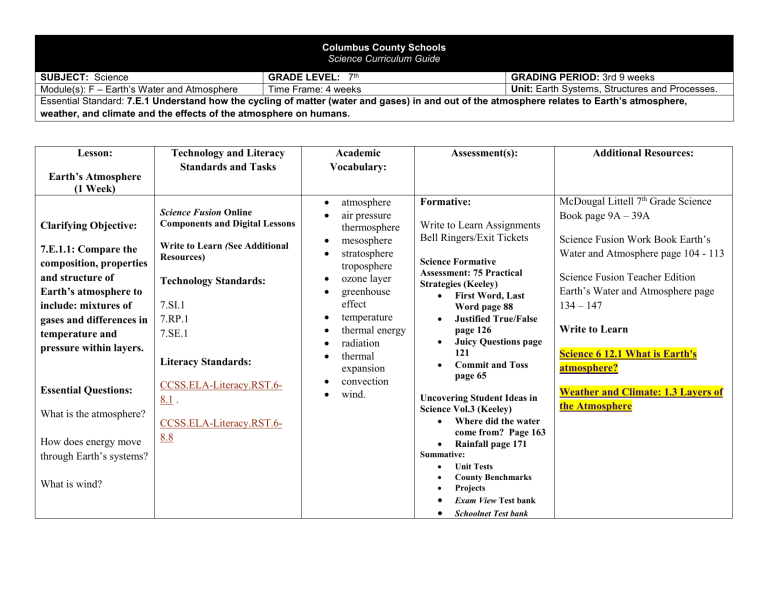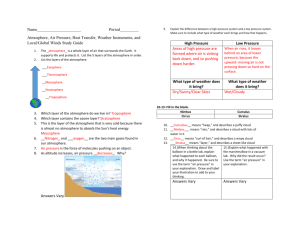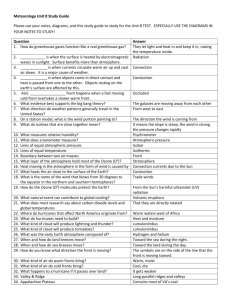Unit-4-Weather-and-Atmosphere-Pacing-Guide-with-Lesson

Columbus County Schools
Science Curriculum Guide
SUBJECT: Science GRADE LEVEL: 7 th GRADING PERIOD: 3rd 9 weeks
Module(s): F – Earth’s Water and Atmosphere Time Frame: 4 weeks Unit: Earth Systems, Structures and Processes.
Essential Standard: 7.E.1 Understand how the cycling of matter (water and gases) in and out of the atmosphere relates to Earth’s atmosphere, weather, and climate and the effects of the atmosphere on humans.
Academic
Vocabulary:
Assessment(s): Additional Resources: Lesson: Technology and Literacy
Standards and Tasks
Earth’s Atmosphere
(1 Week)
Clarifying Objective:
7.E.1.1: Compare the composition, properties and structure of
Earth’s atmosphere to include: mixtures of gases and differences in temperature and pressure within layers.
Essential Questions:
Science Fusion Online
Components and Digital Lessons
Write to Learn (See Additional
Resources)
Technology Standards:
7.SI.1
7.RP.1
7.SE.1
Literacy Standards:
CCSS.ELA-Literacy.RST.6-
8.1
.
What is the atmosphere?
How does energy move through Earth’s systems?
What is wind?
CCSS.ELA-Literacy.RST.6-
8.8
atmosphere
air pressure thermosphere
mesosphere
stratosphere troposphere ozone layer greenhouse
effect
temperature
thermal energy
radiation
thermal expansion convection wind.
Formative:
Write to Learn Assignments
Bell Ringers/Exit Tickets
Science Formative
Assessment: 75 Practical
Strategies (Keeley)
First Word, Last
Word page 88
Justified True/False page 126
Juicy Questions page
121
Commit and Toss page 65
Uncovering Student Ideas in
Science Vol.3 (Keeley)
Where did the water come from? Page 163
Rainfall page 171
Summative:
Unit Tests
County Benchmarks
Projects
Exam View Test bank
Schoolnet Test bank
McDougal Littell 7
Science Fusion Work Book Earth’s
Water and Atmosphere page 104 - 113
Science Fusion Teacher Edition
Earth’s Water and Atmosphere page
134 – 147
Write to Learn
Science 6 12.1 What is Earth's atmosphere?
Weather and Climate: 1.3 Layers of the Atmosphere th Grade Science
Book page 9A – 39A
Lessons: Technology and Literacy
Standards and Tasks
Weather Patterns
(3 Weeks)
Clarifying Objectives:
7.E.1.2: Explain how the cycling of water in and out of the atmosphere and atmospheric conditions relate to the weather patterns on Earth.
7.E.1.5: Explain the influence of convection, global winds and jet stream on weather and climate.
Essential Questions:
Science Fusion Online
Components and Digital
Lessons
Write to Learn (See
Additional Resources)
Technology Standards:
7.SI.1:
7.TT.1:
7.RP.1
7.SE.1:
Literacy Standards:
CCSS.ELA-Literacy.RST.6-
8.5
What is weather and how can we describe different types of weather conditions?
How do the water cycle and other global patterns affect local weather?
CCSS.ELA-Literacy.RST.6-
8.2
Academic
Vocabulary:
Assessment(s): Additional Resources:
weather
humidity
relative humidity
dew point precipitation
air pressure
wind
visibility
Coriolis Effect
jet streams
water cycle
Formative:
Write to Learn Assignment
Quiz
Review Games
Group Assignments
Bell Ringers/Exit Tickets
Science Formative
Assessment: 75 Practical
Strategies (Keeley)
First Word, Last
Word page 88
Justified True/False page 126
Juicy Questions page
121
Commit and Toss page 65
Summative:
Unit Tests
County Benchmarks
Projects
Exam View Test bank
SchoolNet Test bank
McDougal Littell 7 th Grade Science
Book page 9A – 39A
Science Fusion Work Book Earth’s
Water and Atmosphere page 14 – 25 and page 114 - 131
Science Fusion Teacher Edition
Earth’s Water and Atmosphere page
26 – 39 and page 152 - 167
Write to Learn
Science 6 12.2 How do clouds and precipitation form?
Technology Standards Used in this Unit:
7.SI.1: Research topics, use graphic organizers, and evaluate the validity of resources both online and in text.
7.RP.1: Group work and individual research activities using online resources.
7.SE.1: Learn safe practices when using online resources and the proper way to summarize retrieved information.
7.TT.1: Use technology tools to organize information and explore new ways to communicate with peers and teachers.
Literacy Standards Used in this Unit:
CCSS.ELA-Literacy.RST.6-8.1
Cite specific textual evidence to support analysis of science and technical texts.
CCSS.ELA-Literacy.RST.6-8.2
Determine the central ideas or conclusions of a text; provide an accurate summary of the text distinct from prior knowledge or opinions.
CCSS.ELA-Literacy.RST.6-8.5
Analyze the structure an author uses to organize a text, including how the major sections contribute to the whole and to an understanding of the topic.
CCSS.ELA-Literacy.RST.6-8.8
Distinguish among facts, reasoned judgment based on research findings, and speculation in a text.
Day 1
Lesson: Earth’s
Atmosphere
Day 2
Lesson: Earth’s
Atmosphere
Day 3
Lesson: Earth’s
Atmosphere
Day 4
Lesson: Earth’s
Atmosphere
Day 5
Lesson: Earth’s
Atmosphere
Clarifying Objective:
7.E.1.1 Compare the composition, properties and structure of Earth’s atmosphere to include: mixtures of gases and differences in temperature and pressure within layers.
Academic Vocabulary: atmosphere, air pressure, thermosphere, mesosphere, stratosphere, troposphere, ozone layer, greenhouse effect, temperature, thermal energy, radiation, thermal expansion, convection, wind.
Bell Ringer:
Clarifying Objective:
7.E.1.1 Compare the composition, properties and structure of Earth’s atmosphere to include: mixtures of gases and differences in temperature and pressure within layers.
Academic Vocabulary: atmosphere, air pressure, thermosphere, mesosphere, stratosphere, troposphere, ozone layer, greenhouse effect, temperature, thermal energy, radiation, thermal expansion, convection, wind.
Bell Ringer:
Engage Your Brain p. 104
#1 and #2
#9 Student Workbook p.
109
Clarifying Objective:
7.E.1.1 Compare the composition, properties and structure of Earth’s atmosphere to include: mixtures of gases and differences in temperature and pressure within layers.
Academic Vocabulary: atmosphere, air pressure, thermosphere, mesosphere, stratosphere, troposphere, ozone layer, greenhouse effect, temperature, thermal energy, radiation, thermal expansion, convection, wind.
Bell Ringer:
Clarifying Objective:
7.E.1.1 Compare the composition, properties and structure of Earth’s atmosphere to include: mixtures of gases and differences in temperature and pressure within layers.
Academic Vocabulary: atmosphere, air pressure, thermosphere, mesosphere, stratosphere, troposphere, ozone layer, greenhouse effect, temperature, thermal energy, radiation, thermal expansion, convection, wind.
Bell Ringer: Analyzing TE
144
Interpreting Visuals TE p.
144
Clarifying Objective:
7.E.1.1 Compare the composition, properties and structure of Earth’s atmosphere to include: mixtures of gases and differences in temperature and pressure within layers.
Academic Vocabulary: atmosphere, air pressure, thermosphere, mesosphere, stratosphere, troposphere, ozone layer, greenhouse effect, temperature, thermal energy, radiation, thermal expansion, convection, wind.
Bell Ringer: Probing
Question Synthesizing TE p. 145
Instructional Tasks:
“The Atmosphere” Digital
Lesson with fill in notes.
Instructional Tasks:
Lesson Review “Lesson 1:
The Atmosphere” p. 113 in
Student Workbook
Instructional Tasks:
Daily Demo “Transfer
Energy” TE p. 151
Instructional Tasks:
“Energy Transfer” Digital
Lesson with fill in notes
Instructional Tasks:
Atmospheric Review TE p.140
Summarizer:
Summarizer:
Quick Lab “Modelling
Convection” TE p. 151
Summarizer:
What are three things you learned today? How does the atmosphere protect life on Earth?
Have students respond in writing to these labs. There are resources in the Science
Fusion Teacher Resources
Energy Transfer Game TE p.154
Summarizer: Discuss responses to questions on charts.
Assessment:
Participation, Discussion
Assessment:
Observation, Participation that are tied to these activities.
Summarizer:
Pyramid FoldNote p. 154
Assessment:
Observation, Participation
Assessment:
Participation, Discussion
Assessment:
Participation, Discussion,
Observation
Day 6
Lesson: Weather
Day 7
Lesson: Weather
Day 8
Lesson: Weather
Day 9
Lesson: Weather
Day 10
Lesson: Weather
Clarifying Objective:
7.E.1.5: Explain the influence of convection, global winds and jet stream on weather and climate.
Academic Vocabulary: wind, Coriolis effect, global wind, local wind, jet stream
Clarifying Objective:
7.E.1.5: Explain the influence of convection, global winds and jet stream on weather and climate.
Academic Vocabulary: wind, Coriolis effect, global wind, local wind, jet stream
Clarifying Objective:
7.E.1.5: Explain the influence of convection, global winds and jet stream on weather and climate.
Academic Vocabulary: wind, Coriolis effect, global wind, local wind, jet stream
Clarifying Objective:
7.E.1.5: Explain the influence of convection, global winds and jet stream on weather and climate.
Academic Vocabulary: wind, Coriolis effect, global wind, local wind, jet stream
Clarifying Objective:
7.E.1.5: Explain the influence of convection, global winds and jet stream on weather and climate.
Academic Vocabulary: wind, Coriolis effect, global wind, local wind, jet stream
Bell Ringer:
Inferring TE p. 178
Instructional Tasks:
“Wind in the Atmosphere”
Digital Lesson with Fill in
Notes
Summarizer:
What are three things you learned today?
Assessment:
Participation, Discussion
Bell Ringer: How do you think the movement of air would be different if Earth did not rotate?
Instructional Tasks:
Vocabulary Activity
Ex. Frayer Model, Magnet
Words, Word Triangle
Summarizer: What type of weather might a sea breeze carry on to land? Why?
Assessment:
Observation, participation
Bell Ringer: Formative
Assessment TE p. 179
Bell Ringer: Visualize It! p.
140-141 #17 and #18
Bell Ringer:
N/A
Instructional Tasks:
Illustrated Sea Breezes TE p.
173 (you may also have groups illustrate land breezes, mountain breezes and/or valley breezes)
Instructional Tasks:
Unit 3 Review Student
Workbook
Summarizer:
Summarizer:
Visual Summary Student
Workbook p. 142
Explain how the uneven warming of Earth causes air to move.
Instructional Tasks:
Write to Learn: Science 6
12.1 What is Earth’s
Atmosphere?
Or
Weather and Climate: 1.3
Layers of the Atmosphere
Summarizer: Completed
Write to Learn
Assessment:
Observation, Completed poster
Assessment:
Graded Assignment
Assessment:
Completed WTL Activity,
Observation
Day 11
Lesson: Weather
Day 12
Lesson: Weather
Day 13
Lesson: Weather
Day 14
Lesson: Weather
Day 15
Lesson: Weather
Clarifying Objective:
7.E.1.2 Explain how the cycling of water in and out of the atmosphere and atmospheric conditions relate to the weather patterns on
Earth.
7.E.1.3 Explain the relationship between the movement of air masses, high and low pressure systems, and frontal boundaries to storms (including thunderstorms, hurricanes, and tornadoes) and other weather conditions that may result.
Academic Vocabulary: weather, humidity, relative humidity, dew point, precipitation, air pressure, wind, visibility, cloud, cirrus cloud, stratus cloud, cumulus cloud, fog, particulates, air mass, jet stream, front, thunderstorm, hurricane, tornado, storm surge
Clarifying Objective:
7.E.1.2 Explain how the cycling of water in and out of the atmosphere and atmospheric conditions relate to the weather patterns on
Earth.
7.E.1.3 Explain the relationship between the movement of air masses, high and low pressure systems, and frontal boundaries to storms (including thunderstorms, hurricanes, and tornadoes) and other weather conditions that may result.
Academic Vocabulary: weather, humidity, relative humidity, dew point, precipitation, air pressure, wind, visibility, cloud, cirrus cloud, stratus cloud, cumulus cloud, fog, particulates, air mass, jet stream, front, thunderstorm, hurricane, tornado, storm surge
Clarifying Objective:
7.E.1.2 Explain how the cycling of water in and out of the atmosphere and atmospheric conditions relate to the weather patterns on
Earth.
7.E.1.3 Explain the relationship between the movement of air masses, high and low pressure systems, and frontal boundaries to storms (including thunderstorms, hurricanes, and tornadoes) and other weather conditions that may result.
Academic Vocabulary: weather, humidity, relative humidity, dew point, precipitation, air pressure, wind, visibility, cloud, cirrus cloud, stratus cloud, cumulus cloud, fog, particulates, air mass, jet stream, front, thunderstorm, hurricane, tornado, storm surge
Clarifying Objective:
7.E.1.2 Explain how the cycling of water in and out of the atmosphere and atmospheric conditions relate to the weather patterns on
Earth.
7.E.1.3 Explain the relationship between the movement of air masses, high and low pressure systems, and frontal boundaries to storms (including thunderstorms, hurricanes, and tornadoes) and other weather conditions that may result.
Academic Vocabulary: weather, humidity, relative humidity, dew point, precipitation, air pressure, wind, visibility, cloud, cirrus cloud, stratus cloud, cumulus cloud, fog, particulates, air mass, jet stream, front, thunderstorm, hurricane, tornado, storm surge
Clarifying Objective:
7.E.1.2 Explain how the cycling of water in and out of the atmosphere and atmospheric conditions relate to the weather patterns on
Earth.
7.E.1.3 Explain the relationship between the movement of air masses, high and low pressure systems, and frontal boundaries to storms (including thunderstorms, hurricanes, and tornadoes)and other weather conditions that may result.
Academic Vocabulary: weather, humidity, relative humidity, dew point, precipitation, air pressure, wind, visibility, cloud, cirrus cloud, stratus cloud, cumulus cloud, fog, particulates, air mass, jet stream, front, thunderstorm, hurricane, tornado, storm surge
Bell Ringer:
Write a paragraph describing everything you
Bell Ringer: What is the difference between
Bell Ringer: Visualize It!
#10 Student Workbook p.
169 and #13 p. 171
Bell Ringer: What do you think influences weather?
Answer in 2 to 3 sentences.
Bell Ringer: Visual
Summary Student
Workbook p. 192
know about the elements of weather. humidity and relative humidity?
Instructional Tasks:
“Elements of Weather”
Digital Lesson with fill in notes
Summarizer:
What are three things you learned today?
Instructional Tasks:
Cloud in a bottle demonstration
“Clouds and Cloud
Formation” Digital Lesson with Fill in notes
Summarizer:
Complete the flow chart on p. 167 in Student
Workbook
Instructional Tasks:
Finish “Clouds and Cloud
Formation” Digital Lesson
Summarizer:
Instructional Tasks:
“What influences weather?”
Digital Lesson
Name the three factors that are required for cloud formation.
Summarizer:
Explain the factors that influence weather.
Assessment:
Participation, Discussion
Assessment:
Observation, participation
Assessment:
Observation, participation
Assessment:
Participation, Discussion
Instructional Tasks:
“Severe Weather and
Weather Safety” Digital
Lesson
Summarizer:
Stormy Weather Game TE p. 256
Assessment:
Participation, Observation
Day 16
Lesson: Weather
Day 17
Lesson: Weather
Day 18
Lesson: Weather
Day 19
Lesson: Weather
Day 20
Lesson: Weather
7.E.1.2 Explain how the cycling of water in and out of the atmosphere and atmospheric conditions relate to the weather patterns on
Earth.
7.E.1.3 Explain the relationship between the movement of air masses, high and low pressure systems, and frontal boundaries to storms
(including thunderstorms, hurricanes, and tornadoes) and other weather conditions that may result.
Academic Vocabulary: weather, humidity, relative humidity, dew point, precipitation, air pressure, wind, visibility, cloud, cirrus cloud, stratus cloud, cumulus cloud, fog, particulates, air mass, jet stream, front, thunderstorm, hurricane, tornado, storm surge
Clarifying Objective:
7.E.1.2 Explain how the cycling of water in and out of the atmosphere and atmospheric conditions relate to the weather patterns on
Earth.
7.E.1.3 Explain the relationship between the movement of air masses, high and low pressure systems, and frontal boundaries to storms
(including thunderstorms, hurricanes, and tornadoes) and other weather conditions that may result.
Academic Vocabulary: weather, humidity, relative humidity, dew point, precipitation, air pressure, wind, visibility, cloud, cirrus cloud, stratus cloud, cumulus cloud, fog, particulates, air mass, jet stream, front, thunderstorm, hurricane, tornado, storm surge
Clarifying Objective:
7.E.1.4: Predict weather conditions and patterns based on information obtained from:
Weather data collected from direct observations and measurement (wind speed and direction, air temperature, humidity and air pressure)
Weather maps, satellites and radar
Cloud shapes and types and associated elevation
Academic Vocabulary:
weather forecasting, meteorology, station model)
Clarifying Objective:
7.E.1.4: Predict weather conditions and patterns based on information obtained from:
Weather data collected from direct observations and measurement (wind speed and direction, air temperature, humidity and air pressure)
Weather maps, satellites and radar
Cloud shapes and types and associated elevation
Academic Vocabulary: weather forecasting, meteorology, station model)
Clarifying Objective:
7.E.1.6: Conclude that the good health of humans requires: monitoring the atmosphere, maintaining air quality and stewardship.
Academic Vocabulary: ice age, greenhouse effect, global warming
Bell Ringer: Explain three types of severe weather and what you should do if severe weather threatens your area.
Instructional Tasks:
“When Severe Weather
Strikes” Virtual Lab
Instructional Tasks:
“When Severe Weather
Strikes” Virtual Lab (Cont.)
Bell Ringer: How can the paths of past hurricanes be used to predict the paths of new hurricanes?
Summarizer:
What are the four major safety threats from hurricanes?
Summarizer: Explain how meteorologists predict hurricanes. What is the cone of uncertainty?
Bell Ringer: How do you think meteorologists predict the weather?
Bell Ringer: Explain three types of information that meteorologists can get from a station model.
Instructional Tasks:
“Weather Maps and Weather
Prediction” Digital Lesson
Instructional Tasks:
“Forecasting the Weather”
Virtual Lab
Summarizer:
Summarizer:
Responding to Weather Maps
TE p. 272 Explain each of the four types of fronts that meteorologists can forecast.
Bell Ringer: Vocabulary
Matching Activity
Instructional Tasks:
“Forecasting the Weather”
Virtual Lab (Cont.)
Summarizer: How did the weather maps help you predict the weather?
Assessment:
Participation, Discussion,
Summarizer
Assessment:
Observation, Participation,
Summarizer
Assessment:
Observation, Participation
Assessment:
Participation, Discussion
Assessment:
Participation, Observation







